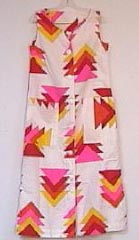I t is a well constructed dress.
The person who sewn it must have had good sewing skills. We do not know if it
was taken from a pattern book or if it was the owner's own design.
|
|
If
we compare the front and the back of the dress they seam to be from
different garments. Why, for instance, there is no waist seam at
the back? Why the princess seams go all the way down at the back
and not at the front? This may have made a difference in the
draping of the dress. Was it because it was too time consuming
to repeat the grid and other details at the back? At least I
would have continued the waist seam at the back, and construct the
back's skirt as the front's, with only two panels. This would have given
some unity and balance to the design. |
The dress represents a common
choice of design, colour, and material of that period. It belongs to the
"street fashions", not to the high street fashions (mass market
brands), nor the up market (exclusive brands and tailored garments), nor the
high fashions (haute coture and designer labels).
CULTURAL
ANALYSIS
The dress was
intended for personal use. Probably for a young woman, though mature women could
dress in "the baby doll look." Mary Quant's shifts and jumpers were
very popular.
In fashion, the sixties were a
combination of very refined styles ( Jacqueline Kennedy and Audrey Hepburn)
with "cheap, flashy, immodest styles" (Brigitte Bardot). There was a
certain balance between the "little girl" and the world-class
sophisticate, not too sweet, not too sexy. During the fifties women had
dressed in very feminine styles ,and it was not acceptable to show too much cleavage, or
too much legs. Women's clothes "were meant to heighten the fantasy
yet keep [them] from being attacked." The appearance of the
mini-skirt changed all that.
Pierre Cardin, Rudi Gernrecih
and Mary Quant were some of the most innovative designers of the '60s who
conceived the Mod Look. Clothes were graphic and bold. Some of the most
popular styles were: metal dresses and helmets, plastic
disks bib necklaces, swirling silk dresses
and tops, bias cut eveningwear, mini's, pants and tunics, A-line dresses and
suits, unisex jumpsuits and other space travel themes.
Colour symbolism:
In western societies green
signifies growth, renewal, health, and environment. On the flip side, green is
jealousy or envy (green-eyed monster) and inexperience.

